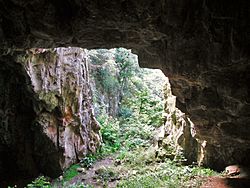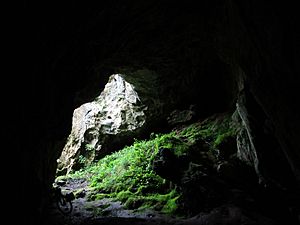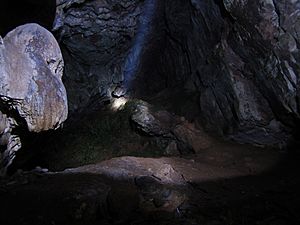Ash Hole Cavern facts for kids
Quick facts for kids Ash Hole Cavern |
|
|---|---|
| Ash Hole, Berry Head Cavern | |

The quarried entrance to the cave
|
|
| Location | Brixham, Devon, England |
| OS grid | SX 93701 56681 |
| Height variation | 10.5 m (34 ft) |
| Geology | Devonian Limestone |
| Entrances | 2 |
| Access | Public |
Ash Hole Cavern is a cool cave system made of limestone rock. You can find it in Brixham, Devon, England. People have lived in or used this cave since ancient times, even as far back as the Neolithic period (the New Stone Age). Scientists have dug here and found many old objects. Since 1966, it has been a special protected place called a scheduled monument.
Contents
Exploring Ash Hole Cavern
To reach Ash Hole Cavern, you walk about 50 metres from Berry Head Road. The path goes through some woods and plants.
The cave is inside limestone rock that formed a very long time ago, during the Devonian period. It has a main chamber that runs from east to west. There are also smaller rooms and cracks. The cave has two ways to get in. One is a natural opening at the bottom of a sinkhole (a hole in the ground) at the east end. The other entrance is bigger. It was made when people were digging for stone in the 1800s.
Besides the large main chamber, there are several smaller rooms. Some of these go deeper into the rock. One room has a lot of loose rocks. This room also goes up to a smaller chamber. You can use a ladder to reach this higher room. The walls of this chamber are covered in flowstone. People have carved their names into it, with some carvings dating back to at least the 1920s.
The cave is located near Shoalstone Beach and the Berry Head Hotel.
A Look Back: History of the Cave
People have used Ash Hole Cavern for shelter for a very long time. There is proof that humans used it during the Bronze Age. Scientists have found pieces of pottery from that time just inside the natural entrance.
There is also evidence that Romans buried people in the cave. Many pieces of old pots, called urns, have been found. Inside these urns, scientists found ashes and bone fragments. These remains are from Roman times. Some Roman coins were also found in 1831. These included coins from the time of emperors Claudius and Nero.
Digging for Clues: Cave Excavations
People have dug in Ash Hole Cavern many times to find out more about its past. Two main digs have been recorded, one in the 1800s and another in the 1900s.
The 1800s Dig
Around 1830, a local person named Rev. Henry Francis Lyte led an excavation.
A writer named Octavian Blewitt wrote in 1832 about the cave. People used to believe that the cave was much larger. They thought one passage led all the way to Kingswear, which is four miles away. The first goal of the dig was to find this passage. They looked everywhere, even breaking through stalagmite (rock formations) in some places. But they never found it. Blewitt concluded that this passage probably never existed.
Blewitt also reported that they dug a deep hole in the lowest part of the cave floor. After digging through about four feet of dirt, they found a layer of bones. This bone layer covered the whole cave floor at about the same depth. They found bones from sheep, cows, rabbits, geese, and chickens. There were so many bones that the diggers were confused. Later, they learned that a large group of soldiers had camped nearby for a whole summer. The weather was very wet, so the soldiers ate their meals inside the cave. This explained all the bones!
The diggers then made the hole wider and dug 20 feet deeper. There, they found parts of a human skeleton. Right below this, they found a lot of charcoal and ashes. They also found bones that had been partly burned, mixed with broken pottery. This showed that the cave had been a burial place, or a "sepulchre." This might be why it's called "Ash Hole" – a place for the ashes of the dead. The pottery was from Roman times. It was rough, not shiny, and had short lines carved on the outside. No complete pots were found, but pieces were saved.
Later, more human skeletons were found. They also found some sling-stones (small stones used as weapons), pieces of brass and ivory, and nicer pottery. They even dug in another part of the cave. The hole in the floor went down 70 feet! But they didn't find anything else super interesting. They never even reached the original floor of the cave. The digging became too dangerous because they were working among huge pieces of rock that had fallen into the cave. Lyte's research helped confirm that the cave was a burial place for Roman soldiers.
The 1900s Dig
Between 1965 and 1967, more pieces of pottery, flint (a type of stone), and a Roman coin were found in the cave's soil. Most of the pottery was from the Bronze Age. It was similar to a style called Trevisker pottery (from about 1750–1000 BC). It was also discovered that people had used the cave during the Neolithic, Iron Age, and Roman times.
Many of the items found in the cave are now on display. You can see them at the Brixham Museum, including the pottery pieces.



